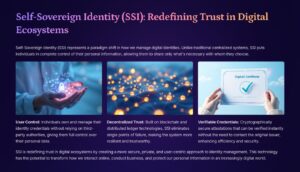A. IAM Logs Hold Secrets You’re Not Hearing
Every day, your Identity and Access Management (IAM) system generates thousands, if not millions, of logs. These logs track who accessed what, when, from where, and under what circumstances. But buried in these cryptic lines of machine-generated text are signals: patterns of misuse, early indicators of insider threats, and gaps in compliance.
The problem? Most organisations treat IAM logs like background noise.
Enter Natural Language Processing (NLP), a powerful branch of AI that can analyse, summarise, and interpret text data with human-like understanding. When NLP meets IAM, something transformative happens: logs start telling stories. And those stories can save you millions.
B. The Volume Problem: IAM Logs at Scale
According to IBM, enterprises deal with over 11,000 security events per day. A typical IAM system generates vast audit trails across authentication, access requests, policy changes, and provisioning.
- A single user logging into 5 systems daily generates 1,500+ events monthly
- Multiply that by 5,000 users and you’re staring at 7.5 million log entries/month
- Only 0.1% of logs get manually reviewed (Gartner, 2023)
That means 99.9% of your IAM intelligence is going unused.
C. Why Traditional IAM Logging Falls Short


IAM logs were never designed for humans. They’re verbose, structured for machines, and often siloed across systems like:
- Active Directory
- SSO platforms (Okta, Azure AD)
- Privileged Access Management (PAM) tools
- Cloud IAM providers (AWS IAM, GCP IAM)
Most logs contain:
- Timestamps
- User IDs
- Access tokens
- Session flags
But what they don’t contain is context.
Example:
UserID: 44322 | Action: ACCESS_GRANTED | Resource: Vault_ShareX | Time: 03:14 UTC | IP: 93.45.113.1
To a machine? Valid. To a human security analyst? Ambiguous. Is it normal? Risky? Suspicious? You can’t tell without weeks of historical pattern mapping.

D. NLP to the Rescue: Making Logs Human-Readable & Actionable
Natural Language Processing steps in where traditional log review hits a wall.
Here’s how NLP transforms IAM logs:


1.) Summarisation:
Instead of parsing 20,000 log entries, NLP can generate summaries like:
“12 failed login attempts from unrecognised IPs between 2–4 AM on inactive user accounts.”
This kind of summarisation is not just a time-saver—it’s a security game-changer. In traditional setups, security analysts would have to manually filter through thousands of logs, searching for patterns or anomalies using rigid queries. NLP can instantly scan through these entries, identify failed login attempts, correlate them with inactive or dormant user accounts, and recognise timing patterns, such as repeated access attempts during low-traffic hours. It doesn’t stop there: NLP systems can cross-reference these with threat intelligence feeds to assess the reputation of the IP addresses involved. The output? A human-readable summary that highlights potential brute force or credential stuffing attacks on neglected user accounts—often the softest targets in an organisation. This actionable insight enables analysts to quickly prioritise alerts and tighten controls around exposed accounts without having to sift through endless technical logs.
2.) Anomaly Detection:
NLP-powered models , often combined with behavioral analytics, detect unusual behavior by comparing log language patterns over time, offering organizations a more dynamic and adaptive approach to threat detection. Unlike static rule-based systems that rely on predefined thresholds or rigid correlation logic, NLP can learn from historical data to understand what “normal” access behavior looks like across different roles, departments, and timeframes.
For instance, a sudden access request to sensitive finance tools by a marketing intern might appear benign in a traditional IAM system. However, NLP models would flag this as an anomaly based on previous usage patterns, peer group comparisons, and semantic analysis of access justifications or logs. The model might notice that the user has never accessed finance tools before, that their access occurred during off-hours, and that the justification message included urgency-driven phrases like “need immediate access.”
By detecting deviations in language patterns and access behavior over time, NLP enables IAM systems to proactively highlight threats that would otherwise be buried under massive log volumes. These systems can continuously evolve their understanding of normal versus abnormal behavior, providing faster, more accurate alerts that help prevent privilege misuse, insider threats, and compliance violations.
3.) Sentiment & Intent Analysis (Yes, Even in Logs):
In IAM environments that capture request justifications or support ticket text, NLP can analyse:
- Tone (urgent, casual, evasive)
- Risk keywords (“urgent access,” “override policy”)
4.) Entity Recognition:
Entity recognition in NLP enables IAM systems to automatically extract meaningful elements from log data, such as usernames, application names, data classification tags, and contextual keywords. These extracted tags are essential for adding depth and context to access events. For example, instead of just logging that a file was accessed, the system identifies that it was a folder labelled ‘confidential,’ accessed by a third-party contractor using a personal device. This enriched data allows for smarter, real-time alerts that are more actionable for security teams. It also aids in compliance by providing traceable access to sensitive data and ensuring policies around data classification are being followed. By automating the detection of specific entities within logs, NLP-driven IAM systems can recognize unusual activity—like repeated access to confidential HR files by a non-HR user—before it escalates into a full-blown incident. Ultimately, entity recognition adds clarity and precision to IAM’s reactive and proactive security functions.
5.) Narrative Generation for Compliance:
NLP can turn raw logs into plain-English audit reports:
“Jane Smith accessed a GDPR-classified folder five times during February using read-only permissions. Access was granted via Okta under HR role-based policy.”
E. Real-World Insight: Enterprises Are Already Adopting This
- JPMorgan Chase is using NLP to analyse access behaviour across its 250K+ employees, detecting access anomalies in minutes rather than days.
- IBM QRadar and Splunk have added NLP plug-ins for security log analysis.
- DARPA’s Cyber-Hunter initiative uses NLP to mine logs for insider threat cues based on behavioural language.



A 2024 Forrester report noted that companies using NLP-augmented IAM systems saw a 29% faster response time to access-related incidents.
F. IAM + NLP: The Technical Stack

As large language models (LLMs) evolve, their ability to generate context-aware narratives, detect nuanced intent, and support multilingual log environments will further push the boundaries of NLP in IAM. This makes the integration of LLMs into existing IAM pipelines a compelling frontier for the enterprise
To make this work, organisations are combining:
- IAM Platforms: Saviynt, SailPoint, Okta, Azure AD
- Log Aggregators: Splunk, Elastic Stack
- NLP Engines: spaCy, NLTK, OpenAI (ChatGPT APIs), Google Cloud NLP
- SIEM/UEBA Integration: QRadar, Exabeam, Sumo Logic


Workflow Example:
- Logs ingested by SIEM
- NLP parses log text and metadata
- Anomalies or narratives pushed to IAM dashboards
- Analyst reviews human-readable alerts or auto-responses are triggered
Use Cases That Matter
✅ Insider Threat Detection
Spotting odd access justifications or repeated denied attempts by users
✅ Compliance Reporting
Auto-generating plain-language access logs for SOX, GDPR, HIPAA audits
✅ Privilege Escalation Alerts
NLP finds subtle context changes such as a user switching from Viewer to Admin role during off-hours, especially when dynamic roles or policy exceptions are in play.
✅ Access Lifecycle Management
Summarizing deprovisioning gaps and access drift across user lifecycle
G. The Way Forward: Your IAM Logs Are Talking. Are You Listening?

In the modern enterprise, identity is the new perimeter. But without visibility, that perimeter leaks.
IAM logs already know the patterns of abuse, escalation, and compliance risk. They just don’t speak your language yet.
By integrating NLP into IAM workflows, you don’t just gain operational efficiency, you unlock:
- A richer understanding of user behaviour
- Proactive control over threats
- Faster compliance responses
In an era where AI is both the challenge and the solution, NLP becomes a strategic force multiplier for your IAM program.


H. Final Thoughts

If you’re serious about securing access at scale, it’s time for your IAM to talk back.





